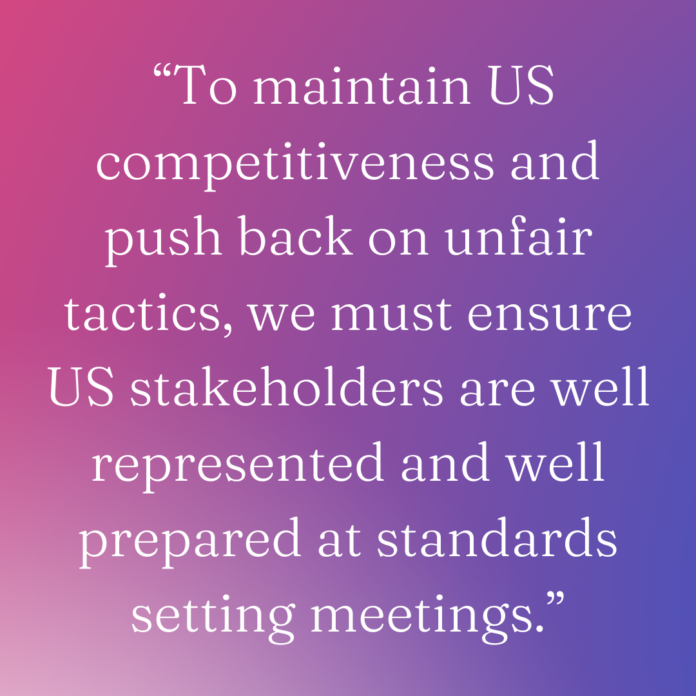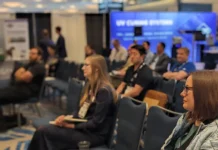Troy Cowan, IUVA Healthcare/UV Working Group facilitator
Exciting news! IUVA has just added another stellar Memorandum of Understanding (MOU) – this time, with the National Institute of Standards and Technology (NIST), memorializing and formalizing our relationship that started with the Healthcare/UV Working Group in 2017. That first visit to NIST headquarters has led to presentations at our Yale Workshop, multiple IUVA conference talks, a full two-day workshop hosted by NIST, and the publication of the book of proceedings from that conference. And now, we’re enlisting NIST’s help in organizing our Wednesday sessions at IUVA Americas in Cincinnati. Yes, yes, yes… Exciting news and a fun ride. Many thanks to our friends at NIST for all they do.
In talking with our friends at NIST, we found out about a recent congressional hearing on “Setting the Standards: Strengthening US Leadership in Technical Standards,”1 where both Chairwoman Haley Stevens, Subcommittee on Research & Technology, and Ranking Member Randy Feenstra extolled the US’s “bottom up” approach to standards setting that relies on an industry consensus2 and the underlying principle that “the idea with the most technical merit wins the day.”3
This further was reinforced by Dr. James K. Olthoff, acting director of NIST, when he affirmed the guidance found in Office of Management and Budget (OMB) Circular A-119, focusing on voluntary, consensus standards’ attributes of “openness, the balance of interest, due process, appeals process and consensus.”4 Dr. Olthoff also shared that these attributes are aligned with those agreed upon by the World Trade Organization Committee on Technical Barriers to Trade, as necessary to ensure standards prevent barriers to international trade.5
Why is this important?
Just look at how many of our UV components come from China and the European Union (EU) and how many of our products are shipped there in return – not to mention the UV products going to and from Canada on a daily basis. That said, not everyone agrees with our “bottom up” / “best idea wins” approach. As shared by Chairwoman Stevens: “…both our allies and our adversaries – are increasingly viewing technical standards as a key part of their domestic technology competitiveness strategy. Within the last year, both the European Union (EU) and the Chinese government laid out ambitious plans to gain supremacy in international standards setting. These goals are legitimate as long as those nations continue to adhere to the merit-based model for standards development. However, we have also seen reports of nations attempting underhanded tactics like coordinated voting to pass suboptimal standards that favor their domestic industries.”6
As an example, the EU issued “An EU Strategy on Standardization Setting Global Standards…”7 in February of 2022. In that document, the EU affirms that “Europe’s competitiveness, technological sovereignty, ability to reduce dependencies and protection of EU values, including our social and environmental ambitions, will depend on how successful European actors are in standardization at the international level. This not only involves strong standardization skills across industry and academia but also requires European standardization to become more agile, flexible and focused to anticipate the standardization needs.”8
Bottom line?
So, the EU is driving this from the top down across all technologies. But, that’s not our style. In fact, Chairwoman Stevens was very clear in her opening remarks:
“…we must be cautious about any heavy-handed government policies that risk doing more harm than good. The United States has long benefited from an open, industry-led, bottom-up approach to most standard setting. Proposals that respond to real or perceived risks to US competitiveness by restricting participation or asserting more government control will almost certainly come back to bite us.”9
In his testimony, Dr. Olthoff clearly defined US standards as “…the technical foundation enabling global trade, competitiveness and innovation…,” with our voluntary, consensus standards system as being “bottom-up, industry-driven and sector focused.”10 While Germicidal UV Irradiation (GUVI) is a small but growing component of the US international market, its importance to our nation’s healthcare sector in these days of ongoing pandemics is unquestioned. Accordingly, we’re aggressively maintaining our healthcare sector focus as we develop new standards that directly address and enhance the credibility and applicability of GUVI technologies and devices, working in close partnership with all of our MOU collaborators (e.g., IES, ASHRAE, NEMA, GLA, EPRI and NIST).
Where are we going?
Chairwoman Stevens also very plainly affirmed, “To maintain US competitiveness and push back on unfair tactics, we must ensure US stakeholders are well represented and well prepared at standards setting meetings.”11 With this in mind, we are reaching out to our MOU collaborators and other organizations in the GUVI community, looking to form a council to define, select, prioritize, coordinate and execute plans for developing the necessary standards to increase the acceptance and ensure the credible application of GUVI technologies across the US and worldwide. Initial rollout is planned for the IUVA Americas Conference, so watch this space. We invite you to join us. More to come.
In the end, it’s all about saving lives.
References
- House Subcommittee on Research and Technology (HSC-R&T), March 17, 2022, (https://science.house.gov/setting-the-standards-strengthening-us-leadership-in-technical-standards), last accessed 27 July 2022
- Video of the Proceedings, HSC-R&T March 17, 2022, (https://youtu.be/g_RgDiPqKZ0), last accessed 27 July 2022
- Chairwoman H. Stevens’ Opening Statement, HSC-R&T, March 17, 2022, (https://science.house.gov/download/cstevens-os-standards), last accessed 27 July 2022
- Dir. J. Olthoff’s Statement to the HSC-R&T, March 17, 2022, (https://science.house.gov/download/olthoff-testimony), last accessed 27 July 2022
- Ibid.
- Stevens, March 17, 2022, (https://science.house.gov/download/cstevens-os-standards), last accessed 27 July 2022
- The European Commission, “An EU Strategy on Standardisation – Setting global standards in support of a resilient, green and digital EU single market,” dtd 2 Feb 2022, (https://ec.europa.eu/docsroom/documents/48598/attachments/2/translations/en/renditions/native), last accessed 27 July 2022
- Ibid.
- Stevens, March 17, 2022, (https://science.house.gov/download/cstevens-os-standards), last accessed 27 July 2022
- Olthoff, March 17, 2022, (https://science.house.gov/download/olthoff-testimony), last accessed 27 July 2022
- Stevens, March 17, 2022, (https://science.house.gov/download/cstevens-os-standards), last accessed 27 July 2022
The IUVA Healthcare/UV Working Group endeavors to promote the acceptance of UV disinfecting technologies as a credible, valued part of environmental management throughout the healthcare industry. In this column, the UV community will be updated on these efforts and the latest information on UV technology as it pertains to the healthcare industry.
Contact: Troy Cowan, [email protected]





